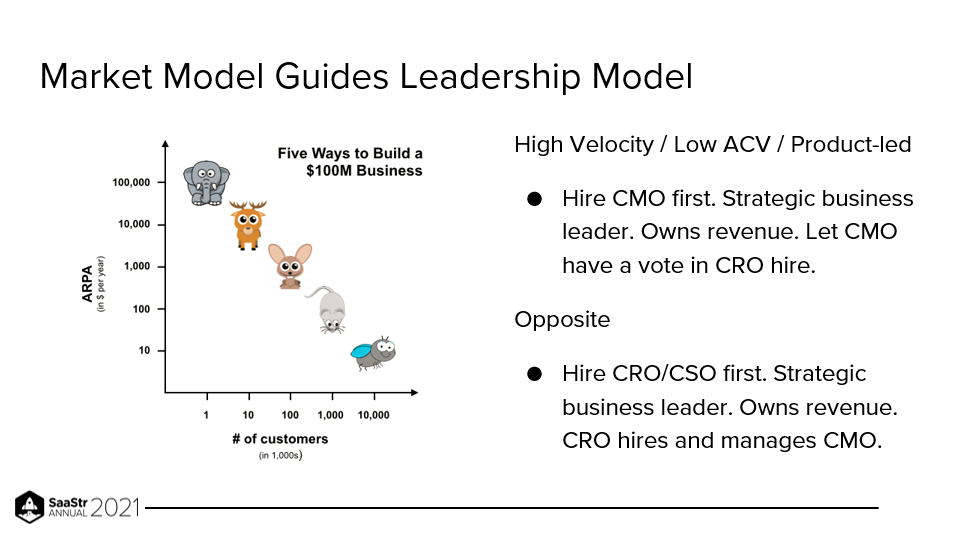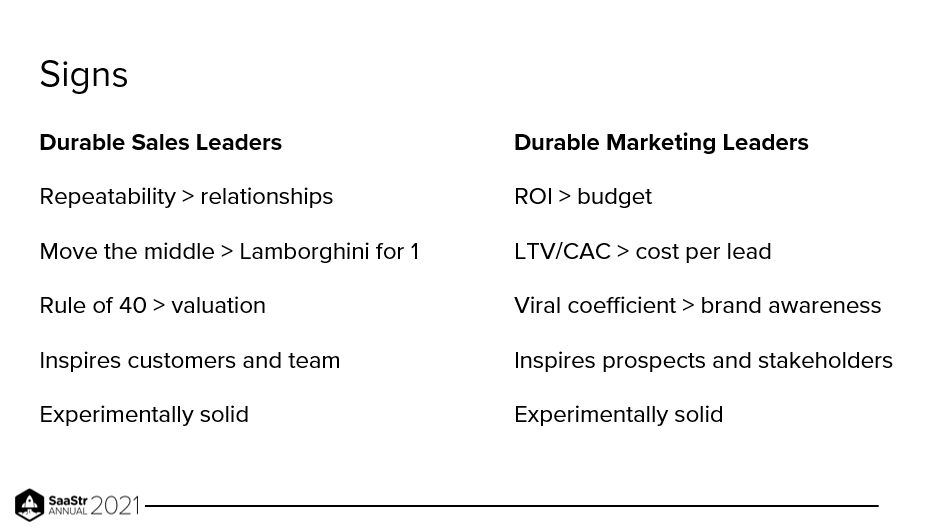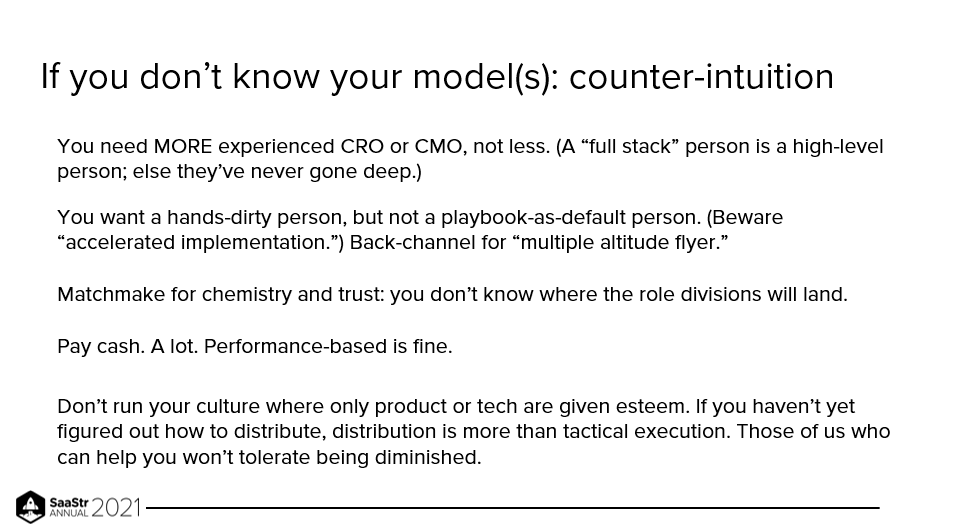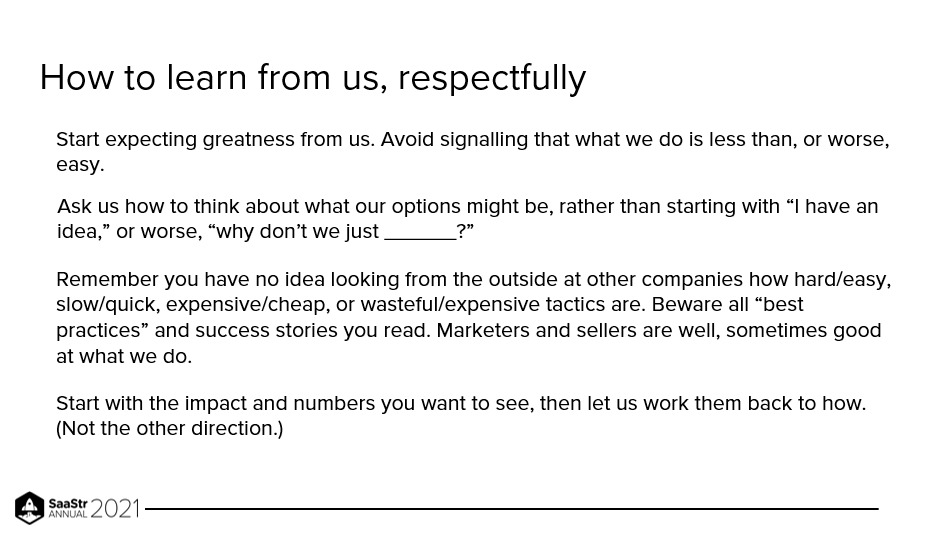It’s the never-ending stereotype –– marketing and sales are eternal “frenemies.” However, this push-and-pull doesn’t have to be part of your organization as long as you hire and empower the right leadership.
In this session, Tolithia Kornweibel, CRO at Gusto, shares advice on creating sustainable partnerships between marketing and sales.
Tip One: Don’t Believe the Hype As You’re Hiring.
It all starts with you as the leader of the company. Avoid sending signals that indicate you anticipate drama. If you enter into the hiring process with the premise that compromises must be made, you will only attract candidates that thrive in that type of environment. As Kornweibel says, “You get what you give. Your attitude going into it [the hiring process], your belief in being able to find the most successful and sustainable partnership leading your marketing and sales organizations is critical to your success from the get-go.”

Tip Two: Always Be Networking
Startups might not be ready to hire sales and marketing leaders in the very early stages of their company life, which is entirely normal. However, these companies should still be networking. Use your network to learn what you need to do differently and plan for the future, not scout for the perfect fit.
Tip Three: Better Recruiting
Don’t get formulaic with your outreach to quality candidates. Reach out directly as the company founder or CEO, lead with what you are doing for customers, and share your pain points. Be wary of harping on your fundraising as well. As Kornweibel says, “A lot of people can raise a lot of money. It doesn’t necessarily mean that it’s a good job. What I care much more about is growth rate –– that’s [sales and marketing leaders’] DNA. We want to grow revenue; we want to grow market share; we want to deepen wallet share. That’s what gets us motivated.”

Tip Four: Know Your Model, Or Be Clear That You Don’t.
Your market model will guide your leadership model. For example, if you have a high sales velocity, low ACV, and your company growth is product-led, you should hire your CMO first. They are your strategic business leader who owns revenue, and they should have a say in the CRO hire. On the other hand, if you’re working with the opposite model, your CRO is your strategic leader that owns revenue, and they should hire and manage the CMO.
Sometimes it’s unclear what your model is, or there is a mixture of both types within one company. In that case, seek out the most experienced CRO and CMO possible, hire hands-on leaders, and matchmake for the chemistry between your marketing and sales leaders when hiring.
Tip Five: Expect Impact, Demand Progress.
Once you have hired the right leaders, you should focus on setting them up for success. Don’t hold back –– set the bar high. If you have quality leaders, they will rise to the occasion.

Tip Six: Both CMO and CRO Should Drive Revenue and LTV
Ensure that both marketing and sales understand that they are both responsible for driving revenue. At the end of the day, they should ultimately measure to LTV. Think long-game.
Tip Seven: Expect Expertise
The CRO and CMO deserve a seat at the leadership table. So here are some pointers for learning from them, respectfully and effectively:
- Expect greatness. Avoid signaling that the CMO and CRO’s work is easy or less important.
- Ask about options instead of dictating your plan or suggestions.
- Looking at other companies’ successes; you won’t always know what things are like behind the scenes. There are no one-size-fits-all best practices.
- Demand the impact you want sales and marketing to deliver, and let the CMO and CRO work on the how.
Tip Eight: Let Revenue Teams Be Peers
Even if you have a stacked sales and marketing team where one leader reports to the other, ensure there is a seat for both at the table to offer input. You want both teams to feel their significance to company success.

Tip Nine: Fire Fast.
When you aren’t confident in your CMO and CRO’s abilities, you need to take aggressive action. If your teams are struggling to maintain a results-driven partnership, you need to assess whether it is worth saving the relationship or if you should keep one leader and let the other go.
Step One: Have a family meeting. Take the smallest possible group aside to share your concerns. Give the teams a short window to sort out differences or problems and return with results, not a plan to achieve results.
Step Two: Risk Assessment.
- Retain the person with the strongest next-in-line leader. A strong next-in-line means they are creating an effective team that will scale.
- Which has the higher inherent attrition risk? Don’t bet on the rising tide.
- After considering the above, determine which will be more valuable to your results in 18 months.
Step Three: Take bold action and fire the ineffective or negative leaders, even if that means both.
Tip Ten: Use GTM Accurately
Utilize your sales and marketing leaders to build a distribution strategy with you and keep the feedback loop open between customers, revenue teams, and the product team.
Key Takeaways
- You set the tone. Avoid an attitude that anticipates conflict during your hiring process.
- Know your business model, and consider that when structuring your sales and marketing partnership.
- Start with the impact that you want the CRO and CMO to deliver, and let them determine the path to achieving the goal.

